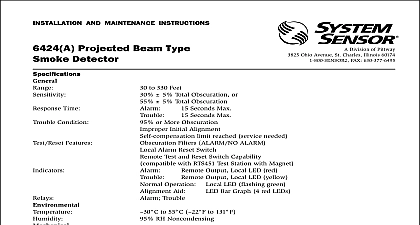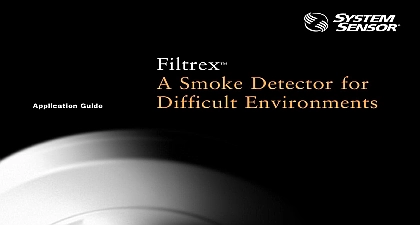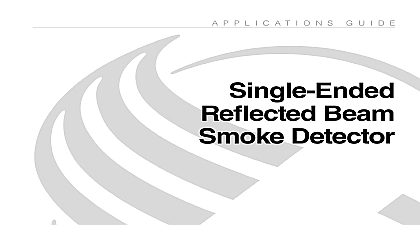System Sensor projected-beam smoke detectors

File Preview
Click below to download for free
Click below to download for free
File Data
| Name | system-sensor-projected-beam-smoke-detectors-1530472896.pdf |
|---|---|
| Type | |
| Size | 860.81 KB |
| Downloads |
Text Preview
C1 Guide Beam Detector Manuals Online A S E R E A R L I E S T W A R N I N G S M O K E D E T E C T O R M O K E D E T E C T O R S I N D U C T A P P L I C A T I O N S Beam Smoke Detectors vs Spot Type Smoke Detectors Beam Smoke Detector Contents Glossary of Operation Detection Feature Application Height Air Velocity Environments Design Requirements and Spacing Conclusion purpose of this guide is to provide information on the proper utilization beam smoke detectors in life safety and property protection applications This briefly summarizes the principles of operation of projected beam smoke their design requirements and practical applications for their use as a of an automatic fire alarm system smoke detectors can be important components of a well designed automatic alarm system Because of their unique capabilities beam smoke detectors overcome many of the problems and limitations of spot type smoke detectors some applications This guide was developed to help the fire alarm designer an understanding of the beam smoke detector capabilities and limitations how they differ from spot type smoke detectors equipment from different manufacturers has varying specifications and the information in this guide is general in nature and should not be used a substitute for the manufacturer recommendations or code requirements Manuals Online R O J E C T E D B E A M S M O K E D E T E C T O R 1 Glossary of Terms device which gives a visible or audible indication of the condition or status as normal trouble or alarm of a smoke detector or system Gain Control AGC ability of a beam smoke detector to compensate for light signal degradation to dust or dirt Rate of compensation is limited to insure that the is still sensitive to slow smoldering fires Smoke Detector Projected Beam Smoke Detector device which senses smoke or smoke and heat by projecting a light beam from transmitter across the protected area to a receiver that monitors the light Smoke and or heat entering the beam path will decrease the light signal an alarm Range distance between the transmitter and receiver Where mirrors are used to the beam the total beam range includes the distance between the mirrors the transmitter and receiver Coverage area in which a smoke detector or heat detector is considered to effectively smoke and or heat This area is limited by applicable listings and codes inclusion of a device in a list published by a recognized testing organization that the device has been successfully tested to meet the accepted Cumulative Obscuration reduction of the ability of light to travel from one point to another due to presence of solids liquids gases or aerosols CUMULATIVE OBSCURATION a combination of the density of these light blocking particles per foot the linear distance which these particles occupy i e smoke density times linear distance of the smoke field device in a projected beam smoke detector system which monitors the level of the light which is sent by the transmitter ability of a smoke detector to respond to a given level of smoke solid and gaseous airborne products of combustion Color relative lightness or darkness of smoke ranging from invisible to white to to black Manuals Online Y S T E M S E N S O R 1 of Terms Density relative quantity of solid and gaseous airborne products of combustion a given volume Detector device which senses smoke and or heat at its location only Spot type detectors a defined area of coverage effect which occurs when smoke which is hotter than the surrounding rises until equal to the temperature of the surrounding air causing the smoke stop rising Projector device in a projected beam smoke detector which projects the light across protected area Filters panel of glass or plastic having a known level of obscuration which can be to test the proper sensitivity level of a beam smoke detector Condition status of a device or system which impairs its proper operation i e circuit on an initiation loop The noti of a trouble condition indicated a control panel or annunciator is a SIGNAL Manuals Online R O J E C T E D B E A M S M O K E D E T E C T O R 2 Principles of Operation beam smoke detectors of a transmitter that projects infrared beam across the protected to a receiver containing a cell which monitors signal strength of the light beam detector works on the principle of obscuration The photosensitive of the beam smoke detector light produced by the receiver in a condition The receiver is cali to a preset sensitivity level on a percentage of total obscura This sensitivity level is determined the manufacturer based on the of the beam the distance the transmitter and receiver more than one setting is for selection by the installer on the length of the beam used a given application For UL listed the sensitivity setting must with UL Standard 268 Detectors for Fire Protective Systems transmitter on some units may be independently from the which can greatly reduce runs and therefore installation Since battery back up is required fire alarm systems battery back would be required for the transmit whether it is powered from the or independently spot type photoelectronic smoke beam smoke detectors are less response sensitive to the of smoke Therefore a beam detector may be well suited to unsuitable for spot type detectors such as where the anticipated fire produce black smoke Beam detectors do require visible and therefore may not be as as ion detectors in some smoke detectors are sensitive to cumulative obscuration presented a smoke field This cumulative is created by a combina of smoke density and the linear of the smoke field across the light beam Cumulative then is a measure of the of light blockage the sudden and total obscuration the light beam is not a typical signature the detector will see as a trouble condition not an This threshold is typically set the manufacturer at a sensitivity which exceeds 90 to 95 total This minimizes the possi of an unwanted alarm due to the of the beam by a solid such as a sign or ladder being placed in the beam path Manuals Online Y S T E M S E N S O R 2 of Operation Detection Feature to the beam smoke detec may include remote annunciators test stations which allow for periodic electronic testing of the and transparencies filters as a go test of the detec proper calibration Some manu provide for the use of mirrors direct the beam Intelligent fire systems can give the beam detector a discrete address to better annunciation of the fire Conventional systems may remotely annunciate through the of relays small slow changes in the quality the light source also are not typical a smoke signature These changes occur because of environmental such as dust and dirt accu on the transmitter and or optical assemblies These are typically compensated for an automatic gain control AGC the detector is first turned on put through its setup program it the light signal level at that as a reference point for a normal As the quality of the light degrades over time perhaps due dust the AGC will compensate for change The rate of compensation limited to insure that the detector still be sensitive to slow or smol fires When the AGC can no compensate for the loss of sig as with an excessive accumulation dirt the detector will signal a trou condition beam smoke detectors incorpo a heat sensing element in the which monitors the frequency the beam pulse Heat attenuates or the pulsed beam which can be by the receiver causing it to This deflection is generally when the fire is closer to the than t


